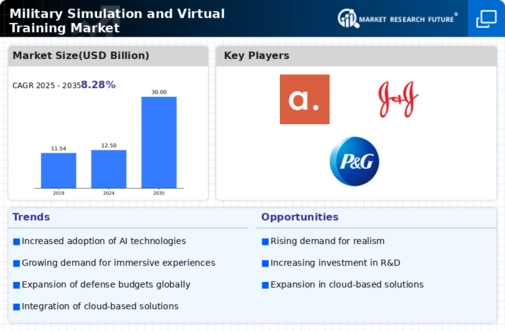Top Industry Leaders in the Military Simulation Virtual Training Market

Strategies Adopted: In the fiercely competitive Military Simulation and Virtual Training market, key players deploy strategic approaches to maintain a competitive edge. Continuous investment in research and development (R&D) is paramount, enabling companies to introduce innovative simulation technologies and virtual training solutions that replicate real-world scenarios. Strategic partnerships with military organizations, educational institutions, and technology providers facilitate collaborative development efforts and ensure the incorporation of the latest advancements in training methodologies. Global market expansion is achieved through participation in defense contracts, international collaborations, and establishing training centers equipped with state-of-the-art simulation facilities, ensuring a broad market reach to cater to the diverse needs of defense forces worldwide.
Competitive Landscape of Military Simulation and Virtual Training Market
- CAE, Inc. (U.S.)
- Thales Group (France)
- L-3 Communications Holdings, Inc. (U.S.)
- Lockheed Martin Corporation (U.S.)
- Northrop Grumman Corporation (U.S.)
- Rheinmetall AG (Germany)
- Raytheon Company (U.S.)
- Rockwell Collins Inc. (U.S.)
- Cubic Corporation (U.S.)
Factors for Market Share Analysis: Market share analysis in the Military Simulation and Virtual Training market encompasses various factors crucial to a company's competitive standing. Technical capabilities, such as offering a comprehensive suite of simulation and virtual training solutions covering various military domains, play a pivotal role. Companies providing adaptable, scalable, and high-fidelity training systems that simulate diverse operational environments are better positioned to capture a larger market share. Compliance with stringent military standards, interoperability with existing defense systems, and the integration of artificial intelligence and virtual reality technologies contribute significantly to market share dynamics. Additionally, factors like customization options, after-sales support, and the ability to address evolving training requirements influence a company's market share by enhancing the overall value proposition for defense customers.
New and Emerging Companies: While established players dominate the market, new and emerging companies are making significant strides in the Military Simulation and Virtual Training sector. Companies like Bohemia Interactive Simulations and Presagis are gaining recognition for their specialized simulation technologies, often focusing on realism, interactivity, and adaptability to various military training scenarios. Emerging companies often bring agility and a fresh perspective to the market, introducing novel approaches and technologies that leverage advancements in artificial intelligence, virtual reality, and cloud computing to enhance training effectiveness.
Industry News: Recent industry news in the Military Simulation and Virtual Training market underscores ongoing developments and trends shaping the sector. Innovations in AI-driven adaptive learning, realistic virtual environments, and advanced debriefing capabilities are gaining prominence. News often covers advancements in multiplayer simulation capabilities, allowing for joint and coalition training exercises in virtual space. Additionally, developments in incorporating data analytics for performance evaluation and customized training scenarios highlight the industry's commitment to providing comprehensive and tailored solutions. Industry news reflects the dynamic nature of the Military Simulation and Virtual Training market, with continuous efforts to improve training effectiveness, realism, and adaptability to emerging military threats.
Current Company Investment Trends: Investment trends in the Military Simulation and Virtual Training market underscore a commitment to technological innovation, scalability, and global reach. Companies are allocating significant resources to R&D initiatives focused on AI-driven training algorithms, virtual reality technologies, and cloud-based training platforms. Investments in cybersecurity measures for secure virtual training environments and the development of adaptive learning systems align with the defense industry's broader goals. Strategic acquisitions of technology startups, partnerships with research institutions, and collaborations with international defense agencies contribute to a comprehensive approach, ensuring a continuous stream of cutting-edge solutions and maintaining a competitive stance in the market.
Overall Competitive Scenario: The overall competitive scenario in the Military Simulation and Virtual Training market reflects a balance between established industry leaders and emerging companies that bring innovation and adaptability to the sector. Established defense contractors and simulation technology providers leverage their extensive experience, global reach, and comprehensive training portfolios to set industry standards. Simultaneously, emerging companies contribute to the diversification of Military Simulation and Virtual Training solutions, often focusing on specific applications or introducing disruptive technologies. The industry's response to evolving military training requirements, technological advancements, and the integration of immersive technologies highlights the adaptability and resilience of Military Simulation and Virtual Training providers. As defense forces globally seek more realistic, scalable, and effective training solutions, the Military Simulation and Virtual Training market is poised for continued evolution. The emphasis on technological advancements, strategic collaborations, and meeting the dynamic needs of modern military training positions this market as a critical enabler for enhancing military readiness and operational effectiveness.
Recent Development:
In April 2021, Science Applications International Corp. secured two substantial contracts from the United States Army, totaling over USD 4 billion. These contracts encompassed the development of modeling and simulation systems engineering, along with hardware-in-the-loop advancements for simulation capabilities at the Aviation & Missile Center.
In January 2021, Top Aces Corp. unveiled the receipt of its initial shipment of F-16 aircraft. These aircraft are earmarked for military air training, specifically catering to pilots tasked with operating F-16s.











